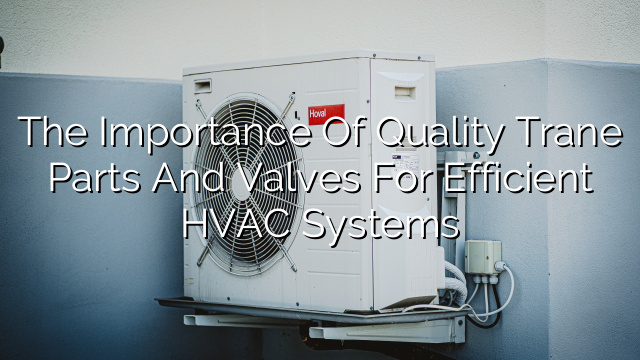Introduction
Trane valves play a crucial role in HVAC systems, controlling the flow of air and water to ensure optimal performance and energy efficiency. Whether you are a homeowner or a facility manager, understanding how these valves work and the different types available can help you make informed decisions about your heating and cooling needs. In this blog post, we will explore everything you need to know about Trane valves.
Types of Trane Valves
Trane offers a wide range of valves for various applications in HVAC systems. Here are some of the most common types:
- Ball Valves: These valves use a ball with a hole in the middle to control the flow of air or water. They are versatile and come in different sizes and materials, making them suitable for a wide range of HVAC applications.
- Globe Valves: Globe valves have a disk or plug that moves up or down to control the flow of fluid. They are often used for modulating flow control, allowing for precise adjustment of temperature or pressure.
- Butterfly Valves: These valves use a disc that rotates to control the flow of fluid. They are lightweight and have a low pressure drop, making them suitable for large volume applications.
- Zone Valves: Zone valves are used to control the flow of fluid to different zones or areas within a building. They can help optimize energy usage by only heating or cooling specific areas as needed.
How Trane Valves Work
Trane valves operate based on the principles of fluid dynamics and pressure differentials. When the valve is open, fluid (air or water) can flow freely through the system. When the valve is closed, the flow is blocked, preventing any fluid from passing through. The position of the valve can be controlled manually or automatically, depending on the type and application.
For example, a ball valve works by rotating the ball inside the valve body, aligning the hole with the flow path to allow fluid to pass through. When the ball is turned, the hole is blocked, stopping the flow. Globe valves, on the other hand, use a plug or disk that moves up or down to control the flow. The position of the plug determines the size of the flow path.
Benefits of Trane Valves
Trane valves offer several benefits that make them a popular choice for HVAC systems. Here are the key advantages:
- Reliability: Trane valves are known for their durability and reliability, ensuring consistent performance over the long term. This reduces the need for frequent maintenance and replacement, saving time and money.
- Precision control: Trane valves are designed to provide precise control over the flow of fluid. This allows for fine-tuning of temperature, pressure, and flow rate, optimizing the efficiency and comfort of the HVAC system.
- Energy efficiency: By effectively controlling the flow of air or water, Trane valves help minimize energy waste and reduce utility costs. They enable zoning, which allows for targeted heating or cooling of specific areas, further enhancing energy savings.
- Compatibility: Trane valves are compatible with various HVAC systems and can be easily integrated into new or existing setups. This flexibility makes them a versatile choice for different applications.
Applications of Trane Valves
Trane valves are used in a wide range of HVAC applications, including residential and commercial buildings, industrial facilities, and healthcare institutions. Here are some common uses:
- Controlling the flow of air in ductwork to regulate temperature and humidity levels
- Controlling the flow of water in heating or cooling systems
- Zone control for multi-level buildings or large facilities
- Modulating flow control for precise adjustment of temperature or pressure
- Preventing backflow in plumbing systems
Maintaining Trane Valves
Proper maintenance is essential to ensure the optimal performance and longevity of Trane valves. Here are some tips for maintaining these valves:
- Regularly inspect the valves for signs of leakage, corrosion, or damage. Replace any faulty valves promptly to prevent further issues.
- Clean the valves regularly to remove any debris or buildup that may affect their performance. Use
FAQ
Q: What are the different types of Trane valves available?
A: Trane offers a variety of valves for HVAC systems, including ball valves, globe valves, butterfly valves, and zone valves.
Q: How do Trane valves work?
A: Trane valves operate based on the principles of fluid dynamics and pressure differentials. They can be manually or automatically controlled to allow or block the flow of air or water.
Q: What are the benefits of using Trane valves?
A: Trane valves are reliable, offer precise control, promote energy efficiency, and are compatible with various HVAC systems.
Q: Where are Trane valves commonly used?
A: Trane valves are used in residential and commercial buildings, industrial facilities, and healthcare institutions for applications such as regulating air and water flow, zone control, and preventing backflow.
Q: How should Trane valves be maintained?
A: Trane valves should be regularly inspected for signs of damage, and cleaned to remove debris or buildup.
Conclusion
In conclusion, Trane valves are essential components of HVAC systems. They come in various types, such as ball valves, globe valves, butterfly valves, and zone valves, each serving different purposes in controlling air and water flow. Trane valves operate based on fluid dynamics and pressure differentials, allowing for precise control over temperature, pressure, and flow rate. These valves offer several benefits, including reliability, precision control, energy efficiency, and compatibility with different HVAC systems. They are commonly used in residential and commercial buildings, industrial facilities, and healthcare institutions. To ensure optimal performance and longevity, regular maintenance and inspection of Trane valves are necessary. Overall, Trane valves are a reliable and efficient choice for HVAC applications.
References
[1] Trane Official Website. Available: https://www.trane.com/commercial/north-america/us/en.html





